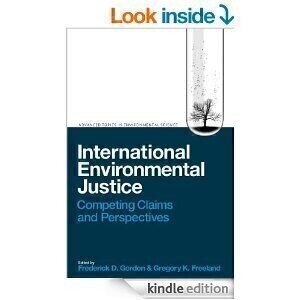Environmental Laboratory
International Environmental Justice - Competing Claims and Perspectives
Nov 27 2014
Understanding environmental justice and the ways in which to achieve it is of vital importance since this area has become such a phenomenon. People, regardless of race; colour; or class, have a fundamental right to protect their environment with regards to the development, implementation and enforcement of environmental laws, regulations and policies that could impact their lifestyle. However, man’s own drive to develop economically has resulted in limited environmental protection.
Everyone experiences risk from pollution and environmental disasters but it is the marginalised communities that carry more of the burden as they have less means to cushion themselves. In vulnerable and disadvantaged communities people are often exposed to treatment and exploitation and the rule of law has fallen short to improve their conditions. People are exposed to poor air quality, toxins and denied natural resources that are a human right, while others over-consume. As a result they risk their livelihoods and are forced to relocate to over-crowded cities whereby the quality of living is no better. People may have to resort to working in unhealthy conditions in petrochemical plants but have no other choice due to economic pressures.
This book, Now available as an eBook from Amazon, extends beyond domestic environmental justice to that of the injustices at a global level from deep-water oil spills to nuclear plant disasters. Disadvantaged communities are now forging links with environmental organisations and human rights groups and are finding a voice. The social movements discussed in this book reflect the global voices that are emerging worldwide with the aim of achieving environmental justice – safe drinking water, clean air, food, climate stability and soil conservation.
This book contains 8 chapters that cover a range of topics including an introduction to understanding environmental justice claims and means of achieving environmental justice in the USA; the Anti-Liquid Natural Gas Movement plans and strategy in California; a case study detailing the collaboration for access to clean water for indigenous people in Tulum, Mexico; petroleum extraction and the associated environmental impacts on local communities; environmental equality in Nepalese community forestry; the social, political and environmental implications behind the construction of largest dam project in Africa - the Lesotho Highlands Water Project; and indigenous rights and justice in environmental politics.
This book, edited by Gregory K. Freeland, Professor and Chair of the Political Science Department at California Lutheran University, and Frederick D. Gordon, Assistant Professor of Political Science at Columbus State University, was partly inspired by Gregory’s sister who was an early leader in the organised actions of what became known as the national environmental justice movement. Environmental injustice peaked in North Carolina in 1982 when the state decided to create a dump to hold 60,000 tons of toxic soil contaminated with PCBs. It was the protest actions of the indigenous citizens that gave uprising to this movement and allowed the environmental justice movement to grow into the influential group that it is today helping others in their struggle for health, safety and equality.
Digital Edition
IET 34.2 March 2024
April 2024
Gas Detection - Biogas batch fermentation system for laboratory use with automatic gas analysis in real time Water/Wastewater - Upcycling sensors for sustainable nature management - Prist...
View all digital editions
Events
Apr 30 2024 Melbourne, Australia
Apr 30 2024 Birmingham, UK
May 03 2024 Seoul, South Korea
May 05 2024 Seville, Spain
May 06 2024 Minneapolis, MN, USA


















